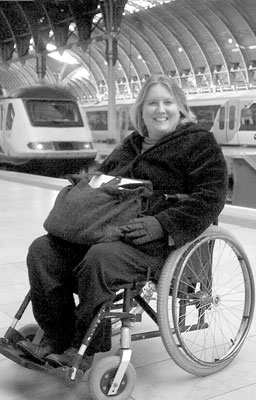Wheeling and dealing with Europe
As long as I’ve been writing, my passion has been to make Europe accessible. I’ve focused on economic accessibility (you don’t need to be rich to travel) and intellectual accessibility (you don’t need to be a scholar to enjoy Europe’s history and art). But I also want to make Europe physically accessible for slow walkers and wheelchairs users.
With this in mind, I teamed up with Dr. Ken Plattner to write “Rick Steves’ Easy Access Europe,” a guidebook on London, Paris, Bruges, Amsterdam and the Rhine for travelers with limited mobility.
Here is some useful advice we learned from our research. I’d like to credit Susan Sygall, executive director of Mobility International USA, for her organization’s help.
Resources
When planning a trip where mobility is a factor, the Web is a great resource. Contact the national and local tourist offices in the destinations you’ll be visiting (for example, www.visitlondon.com, www.paris-touristoffice.com, www.brugge.be and www.amsterdam.nl). They can often provide you with material geared for travelers with limited mobility and can generally put you in contact with local disability organizations. The Graffiti Wall at www.ricksteves.com also has helpful reports of firsthand experiences by travelers with mobility challenges.
Mobility International USA is an excellent resource. While they specialize in matching up disabled travelers with international study and exchange programs, they are helpful for any traveler with mobility limitations.
Along with “Rick Steves’ Easy Access Europe,” consider Candy Harrington’s book, “Barrier-Free Travel: A Nuts and Bolts Guide for Wheelers and Slow Walkers.” Her quarterly magazine, Emerging Horizons, also offers good, carefully updated information for travelers with limited mobility.
Getting to Europe
U.S.-based air carriers are required to accommodate travelers with limited mobility; air carriers abroad have significantly different rules. Understand the Air Carrier Access Act and use a U.S.-based carrier whenever possible. Every U.S.-based flight has a Complaints Resolution Officer (CRO) who has the authority to make sure your rights are respected.
Think carefully about flight length. You may find long flights uncomfortable if you can’t use cramped airline toilets (request a flight with accessible toilets). Shorter connecting flights can be a good alternative.
At the airport, insist on staying with your wheelchair or walker as long as possible (preferably until you board the plane), then have it stowed on board and request that it be brought to the gate immediately upon landing.
Many transportation companies (such as airport shuttles) offer accessible vans — though you usually have to reserve in advance.
On Eurostar (“Chunnel”) and Thalys (Belgian) trains, wheelchair users and their companions pay a reduced fare and get to ride in the accessible first-class cabin.
On the road
Wheelchair users and their companions are often eligible for free entry or other discounts at many sights — and can usually go directly to the head of the line. At a museum or a similar venue, ask to use the freight elevator if no others are available.
Hotels have different ideas about what “accessibility” means. When booking your accommodations, be as specific as possible about your requirements (e.g., dimensions of ramps, doorways and elevators). Some rampless but so-called “accessible” hotels will want to manually carry you up their entry steps. Be open to trying new ways of doing things, but also ask questions to make sure you are comfortable with the access provided.
In London, a few downtown stops on the underground (especially on the Jubilee Line) are accessible to wheelchair users (see the free Accessible Tube Map at www.thetube.com). For a specific trip, Transport for London’s online Journey Planner will figure out if you can get to your destination without encountering barriers. (Log on to http://journeyplanner.tfl.gov.uk, click on “Journey Planner,” then on the yellow “More Options” button and look for the “mobility impaired access” section at the bottom of the page.) Aboveground, London Taxi International’s “black cabs” are wheelchair-accessible.
In Paris, the Métro is generally not accessible and taxis are the way to go.
Per capita, we found better accessibility in Bruges, Belgium, than in any other European city. For example, its cobblestone streets have a paved, easier-for-wheels strip in the middle (see www.accessiblebruges.be).
Amsterdam’s canals are a joy by boat. Some of the tours offered by Rederij Noord-Zuid (tel. 020/679-1370) use boats that are fully accessible.
Most quaint villages in Germany’s Rhine River Valley offer poor accessibility, including our favorites, Bacharach and St. Goar (though the popular Rhine cruises are generally accessible). In larger towns such as Koblenz and Mainz, wheelchair users enjoy much better access. The disabled community in Mainz runs a fine hotel called the INNdependence.
Prompted by increasing numbers of travelers with disabilities, European countries are working harder to improve the accessibility of their sights and services. No matter how slow you need to travel, you can handle Europe. I hope this information gives you the inspiration to try.”

